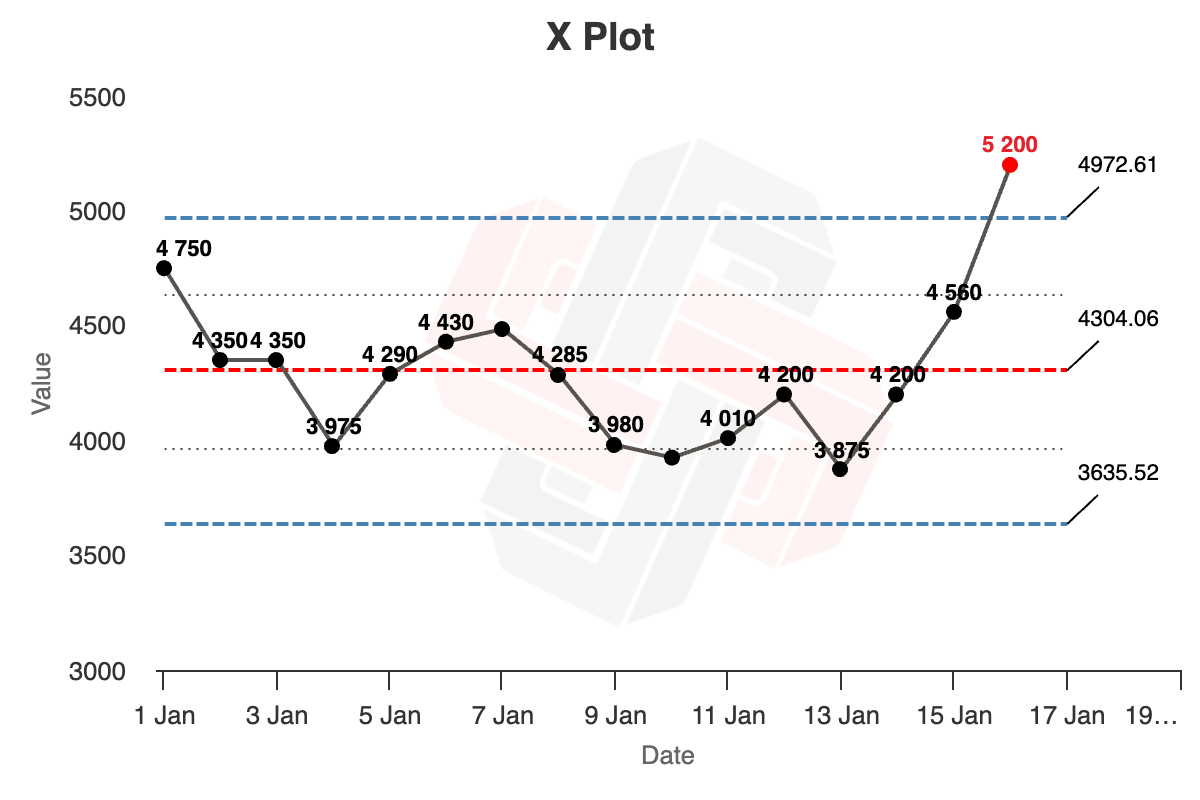New article: Variation Is King, Not The Average
Your
Sales
Orders
Leads
Calls
Returns
Delays
Went
Down↓
Up↑
Last Week.
Should You Be Worried?
Enter your email to start a free email course on using XmR charts:
One week long. No spam. Just the basics.
Have you ever looked at a business metric and felt … confused?
If you look at lots of numbers in your business, you might know the feeling. Sometimes your numbers go up, and sometimes they go down.
But do you know if a change in your numbers is normal? Do you know if it's abnormal?
Can you say, for certain, that a change is something you should be worried about? Or that it's just business as usual'?
This not an idle question. If you don't know whether your numbers are normal or abnormal, then you're flying blind!
You don't know what to investigate.
You may waste time looking into something completely irrelevant.
Or, worse, you might miss something going horribly wrong with your business.
Most business metrics are extremely noisy. They wiggle up and down.
This might sound like a dumb problem, but it's actually really important!
If you can't deal with this noise, you won't be able to do a lots of things:
- You won't know if things are getting better or worse!
- You won't know which specific data point is worth investigating!
- And, perhaps worse of all, you won't know if a change you've made has actually made things better.
And how can you? Your charts are wiggling all the damn time.
As a result, if you can't deal with noise, then you fundamentally cannot become data driven.
Imagine if you could know, for SURE, whether the numbers you're looking at are normal … or not.
Imagine that you don't need to ask your data team for some fancy analysis.
You don't need to ask an experienced employee in your company to tell you if things look ok.
You can just plug numbers into some tool, and be confident that:
- Things are ok, it's business as usual, or
- Things are not ok, go investigate!
Wouldn't that be nice?
If it really works, this should unlock a lot of things for you:
- You'll know if things are getting better (or worse) with certainty.
- You'll know exactly which data points you need to investigate.
- You'll know if a change you've made has actually worked.
Everyone needs this kind of confidence.
XmR charts are a 90 year old solution that will give you that confidence.
XmR charts are very simple! They look like this:

In this particular case, you should investigate the red point.
XmR charts are a great entry-level tool to help you make sense of the noise in your business numbers. No maths required.
You can try it with pretty much any metric in your business.
More importantly, you can use it on your own. No need for fancy software. No need for a degree in data science. Give it a minute before you reach for some fancy maths.
Xmrit (pronounced 'xa-merit') allows you to make XmR charts very easily in your browser.
Go on, give it a spin! Paste some numbers you care about and see if there's anything abnormal going on:
Want to learn more?
We have a free course that will teach you the basics for using XmR charts in practice.
The Free Xmrit Email Course
Want to quickly get started with XmR charts? You'll learn …
- How to use XmR charts to take action in your business.
- Four major ways to use an XmR chart!
- When XmR charts don't work so well.
- When you can and cannot trust your limit lines.
- And more …
One week. No spam. Just the basics.
Testimonials
“XmR charts is the gateway drug that I started using for clients. They no longer ask why sales were high yesterday or low last week!” - JB“Xmrit is the missing piece to generalize Statistical Process Control methods to business in general. It is immediately easy to understand and simple in the right way.” - Jacob Matson
“Process behavior charts can help solve the ubiquitous problem of decision-making under low data availability and low tech penetration pervasive in supply chain functions. I plan to educate my clients to replace KPI dashboards with XmR charts. The Xmrit tool and the course could not have come at a better time!” - Mrugank Modiya
Latest Articles
- Variation Is King, Not The Average
- Why You Should Not Use Spreadsheets to Make XmR Charts
- Xmrit Launches Trend and Seasonality Features for XmR Charts
- What Makes a WBR Special?
- Don’t Run Your Business on Superstition
- How Would You Know?
- Explaining Where XmR Chart Scaling Constants Come From
- How Often Should You Measure Your Business Processes?
- Setting Better Controllable Input Metrics - Going Up a Level
- Constraints are Good for Metrics
- Building Your Data Sense
- The Gift of Exceptional Variation
- Why Locking Limits is Essential for XmR Charts
- Launch: The Metrics Masterclass
- Data Is Just an Added Sense
- Getting Started with Data Collection
- SaaS Metrics for XmR Charts
- Why Defining Your Metrics is so Important!
- How to Plot an XmR Chart
- The Purpose of Data is Knowledge
More Resources Below
- Here's the user manual, along with a short explainer of XmR charts.
- Read the Commoncog essay that started it all — which explains how you might use XmR charts to bootstrap a causal model of your entire business.
- Read our privacy policy for full details on analytics and event tracking. The short of it is: everything happens in browser; none of your data ever hits our servers. We want you to be comfortable using your company's operational data with Xmrit.
- Of course, you still might not trust us. For that reason Xmrit is open source.
- Please give us feedback using this form.
- Check out our paid, soup-to-nuts course on using XmR charts to gain control of your business: The Metrics Masterclass.
The end goal is to make more operators and more companies data driven.
With love,
Sam, Cedric and the Xmrit team.
